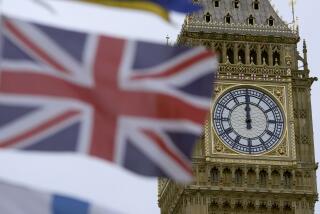Despite Electoral Losses, Don’t Count Thatcher Out : Britain: With the left splitting its vote, Conservatives might stay on top. But a Liberal Democrat win could mean a proper Bill of Rights.
- Share via
WASHINGTON — Two weeks ago, Margaret Thatcher’s Conservative Party lost a special election in Eastbourne, on Britain’s south coast, slap bang in the middle of what is assumed to be the Conservative heartland. The consequence is that Thatcher now looks a better bet to win the next British general election--which must be held by the summer of 1992--than she has for ages.
That seemingly strange conclusion flows from Britain’s odd electoral politics. Britain’s method of elections is the same as the United States--in single-member districts, the candidate with the most votes wins. But when, as in Britain, there are three political parties, the results, to American eyes, can look unexpected. In Eastbourne, the Conservatives lost the seat--previously held by Sir Ian Gow, who was murdered by Irish Republican Army terrorists during the summer--to the third of those parties, the Liberal Democrats.
To understand why that loss helps Thatcher, remember that in her three election victories--in 1979, 1983 and 1987--her party has never won more than 43% of the popular vote. That, however, has been sufficient for her to rack up huge majorities in the House of Commons, simply because the remainder of the vote has been split between the Labor Party and the third force--called the Liberal Party in 1979, and the Social Democratic-Liberal Alliance in 1983 and 1987.
If Britain had a system of proportional representation, where parties’ strength in the House of Commons mirrored the proportion of votes won in general elections, Thatcher would have had a minority of seats in the Commons for most of her time in office.
It follows that the best way for the Labor Party, presently leading in the polls, to overthrow Thatcher is for the third party to disappear. In particular, although Labor runs second to Thatcher in most Conservative-held seats in the north England, Scotland and Wales, it typically runs third to her in Conservative-held seats in the far more populous south of England.
Labor cannot win a national election without breaking out of its heartland in the north; it must win seats in the south. But its chances of doing so are diminished to the point of vanishing if the Liberal Democrats show themselves capable of doing well there, and hence split the anti-Conservative vote. Eastbourne proved that the Liberal Democrats still have strength in the south.
As in any special election, there were peculiar features in Eastbourne. The Conservatives chose an inept candidate, who suggested--to the outrage of the good folk of Eastbourne--that any vote for a party other than his was a vote for terrorism. The Liberal Democrats had a strong base in local government. But those factors notwithstanding, special-election victories are the oxygen Liberal Democrats thrive on. If the Eastbourne result pushes them up in the polls, from the 10% they are more or less getting now to something like 18% over the next few months, Thatcher is home free.
The abiding attraction of a center party is one of the fascinations of British politics. In the early 1980s, when a group of right-wing Labor Party leaders broke away to form the Social Democrats and create an alliance with the old Liberals, the center regularly outpolled both Labor and Conservatives. In the 1983 election, the Alliance polled 27% of the vote (for about 7% of House of Commons seats)--only just below the level of support for Labor. But it could not repeat that success in 1987. After that election, the Alliance fell apart. A rump of Social Democrats, led by David Owen, Labor’s Wunderkind foreign secretary in the ‘70s, broke with the majority of Social Democrats and Liberals, who agreed to merge their parties into the Liberal Democrats.
It is only this year that Owen has faded away, leaving the field to the Liberal Democrats. Eastbourne demonstrates that, once the post-1987 confusion Owen introduced was removed from the center, the Liberal Democrats would consistently poll around 15%--and sometimes much more.
The conventional wisdom is that this support has always been a kind of plague-on-both-your-houses protest vote on the part of those who despise Thatcher but cannot stomach Labor--quite a lot of people, for quite good reasons. That has always mystified me. A vote for the center embodies a perfectly coherent outlook on modern Britain: The economic policies that Thatcher rammed down the country’s throat were the only real alternative to the malaise that gripped the postwar British economy, but the statism, authoritarianism and nibbling-away of civil liberties that Thatcherism stands for was deeply repugnant.
To these reasons for voting for the center there now has to be added another. The Liberal Democrats are the only party seriously talking of constitutional reform in Britain--of a Bill of Rights, regional government and some appreciation that the gradual coming-together of Western European countries will demand a reappraisal of Britain’s internal constitutional arrangements.
This, it hardly needs saying, is not an issue that exactly grabs the attention of the great mass of the British electorate. It’s one for the elites--constitutions, I guess, always are--and may stay that way. But perhaps not. The pace of European integration is forcing, everywhere throughout Western Europe, some examination of the adequacy of domestic systems of government within what may one day be a European confederation. The Liberal Democrats, who historically have been “pro-Europe,” are well-placed to take advantage of that mood.
The paradox, to return to the starting point, is that their relative success does little more than guarantee continued Conservative government. Yet even that cannot be assumed to be an eternal verity. The split in the Conservative Party between those who believe in European integration and those who oppose it is now almost as significant as the split in the party over the Corn Laws 150 years ago. As Britain comes out of its amazing 1980s, when so much of its world was turned upside down, it enters a decade when its political map may be substantially redrawn.
More to Read
Sign up for Essential California
The most important California stories and recommendations in your inbox every morning.
You may occasionally receive promotional content from the Los Angeles Times.










